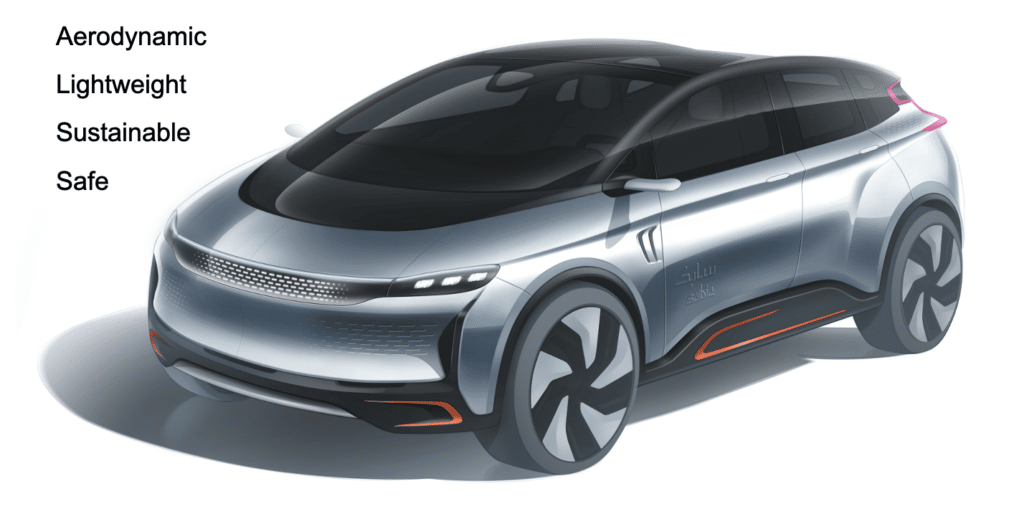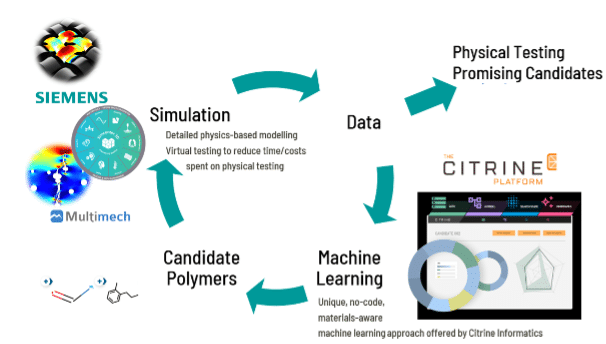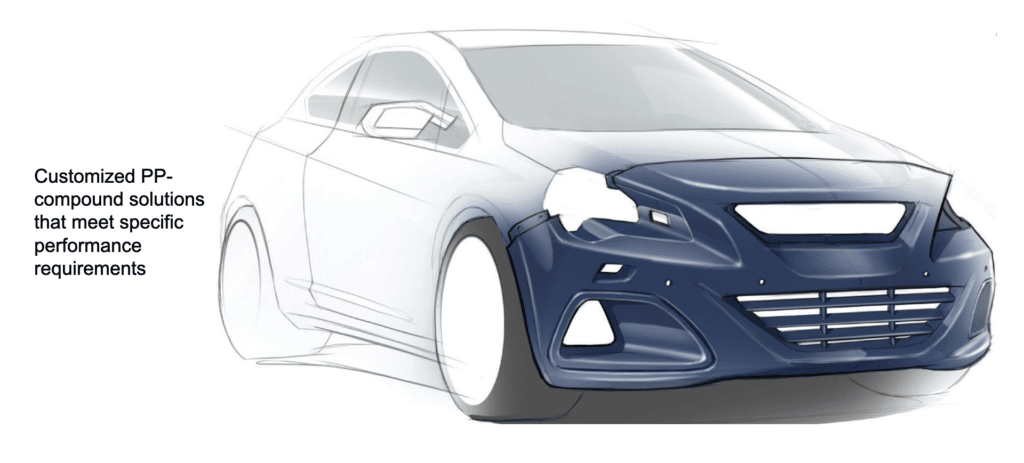Industrial challenge
It goes largely unnoticed by most consumers, but thermoplastics are used in a wide variety of automotive applications such as plastic tailgates, instrument panel carriers, bumpers, and many others. As nations and regulators around the world push for higher efficiency standards, next-generation vehicles will feature even more thermoplastic components and systems such as battery and body-in-white structural components.
When applied in combination with optimized component design, thermoplastic solutions enable weight savings, which benefit performance as well as fuel and energy efficiency. In addition, functional integration such as unique design elements, safety features, and aerodynamic features with less raw material offers cost optimization potential. However, to achieve these goals, a combination of predictive engineering tools, processing techniques, and material design must be used.

- Thermoplastic materials such as PP-compounds (PP-c) are based on polypropylene and blended with other ingredients, such as glass fibers or mineral fillers, to increase performance. PP-c are applied for many applications within and beyond the automotive industry. The specific needs in the automotive market vary per customer and dictate the need for customer and application tailored PP-c solutions.
- Currently, product design is an experiment-intensive process in which long development times limit the value of the solution. Also it is difficult to apply material modifications during the application development process.
- Customized Solutions (CS) offer some solution to this. CS is a concept in which a concentrate PP-c (master batch) is diluted by the customer with the corresponding PP polymer to achieve desired properties. The polymer supplier typically provides advice on which CS system to select and what dilution ratios to use for a specific application [3]. Although this approach enables the customer to reach material performance tailored to the application at hand, in a more time and cost-efficient manner, the exact ratio between masterbatch and polymer needs to be fine-tuned by the customer via experimental tool trials, which involves an expensive and time-consuming process.
Having the ability to better select the right system-component combination and mixing ratio for a specific application before starting experimental tool trials would significantly shorten the time and cost to fine-tune the CS.
Solution
Materials Informatics Overview
A materials informatics platform like the Citrine Platform helps product developers and scientists identify material compositions that will meet performance targets or customer requirements via machine learning (ML) models trained on historical data [1]. This offers the potential for custom thermoplastic producers to rapidly identify custom masterbatch + polymer blends for its PP Customized Solutions with far fewer experiments than traditional approaches to product development.
Applying Materials Informatics to Develop Custom Polymer Blends
Using the Citrine Platform with historical material data, the team generated a search space of all products that were possible to formulate based on customer requirements and geographic availability by means of model predictions. This allows customers to identify optimal ratios and provides insight on the performance of specific masterbatch-polymer combinations without experimentation, while also providing insight to the polymer supplier on which customer is interested in what information, allowing tailored pro-active support.

Incorporating Physics-based Simulation in ML-guided Product Development
The materials design space is enormous, and there is an imminent need for materials-aware Artificial Intelligence (AI), helping engineers to navigate the materials design space and design/select new and adequate materials [2]. Siemens Digital Industries Software (DI SW) targets the complementary use of physics-based simulation and data driven modeling to further improve efficiency for materials discovery connected to product development. Siemens DI SW brings in its Simcenter 3D software for materials engineering and multi-attribute simulation based on physics-based models. As global leader in data driven materials informatics, Citrine Informatics completes the solution space with its leading Machine-Learning (ML-)guided approach.

Along this rationale, Siemens DI SW is partner in the research and innovation project DOME 4.0 (Digital Open Marketplace Ecosystem 4.0), aiming to realize a digital platform for connecting materials data sources to data users with many stakeholders involved. Data transactions will be cleared, reported and sufficiently anonymized to protect the privacy of platform participants. The aim is a step change in materials data exchange across organizations and collaboration ecosystems. This is expected to enable efficient usage of (meta) data for virtual materials engineering and product design applications, and to foster new business models that capitalize on cloud-based workflows. As a global diversified chemicals company, SABIC is an industrial EAB (External Advisory Board) Member in DOME 4.0. The technology innovation work presented in this blog post is being worked out as Showcase 9 in the DOME 4.0 project, by Siemens DI SW, Citrine Informatics and SABIC.
Key Results
End user value:
- Customers can be supported with more accurate recommendations on the masterbatch and polymer ratios for its Customized Solutions in a faster and more easily accessible way.
- If a customer changes its application criteria, typically the process of determining correct system and ratios restarts from the beginning. In a new ML-guided workflow, predictive models can be used to assess the feasibility of the material combination in the new application, without having to rely on additional physical experiments. This improves customer’s experience, while also saving material, time, and money.
- New or changed ratios imply a change in physical properties, like stiffness or impact strength; this ML-guided approach gives additional insights on the physical properties of new combinations even before doing experiments in the lab.
- In a future state, a customer-facing website will enable quick access to the information by material supplier’s customers. The feasibility and potential of this approach is being explored in the ongoing DOME 4.0 project.

Acknowledgement
Citrine Informatics acknowledges the support of the European Commission for the Horizon 2020 Research and Innovation project “DOME 4.0” (see https://dome40.eu/), with Grant Agreement No. 953163, coordinated by CMCL.
This blog post reports the technology innovation status of Siemens DI SW, SABIC and Citrine Informatics for Showcase 9 “Virtual Development of Composite Materials” in DOME 4.0.

References
- Citrine Informatics, “What is Materials and Chemicals Informatics?”, Citrine Website, 2022. [https://citrine.io/what-is-materials-informatics/]
- Stephen Ferguson, “The New Science of Digital Materials”, Simcenter Blogpost, February 25, 2021. [https://blogs.sw.siemens.com/simcenter/the-new-science-of-digital-materials/]
- SABIC, “Enhancing efficiency and durability – SABIC® PP compounds for higher performance applications with potential cost savings”, SABIC Brochure, 2019.
[https://www.sabic.com/assets/en/Images/SABIC-PP-Compounds-Brochure_tcm1010-18615.pdf]